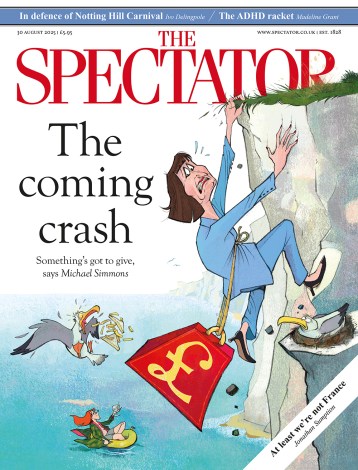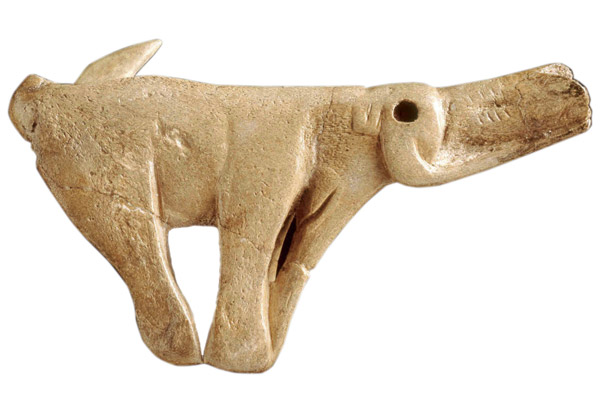The best way to approach any exhibition is with a clear and uncluttered mind, without expectations or prejudices. Of course this is often impossible, for all sorts of reasons, particularly when we have some familiarity with the subject on view. Inevitably we are besieged by images and opinions before we enter an exhibition of Manet or Picasso, but with Ice Age Art I was able to approach without any troubling preconceptions. I arrived at the British Museum in a state of pleasant anticipation, and within minutes I was entirely won over. The curator, Jill Cook, has given us an extraordinary glimpse of a long-distant age which yet feels incredibly fresh and relevant to us today.
The exhibition’s subtitle is ‘arrival of the modern mind’ and its thesis — that Ice Age art gave us the first figurative art in the world and thus encompassed the dawning of how we think now — is entirely convincing. Yet the sheer ancientness of this work can be daunting. The last European Ice Age occurred between 40,000 and 10,000 years ago, and these numbers are literally mind-numbing. The first object in the exhibition is a small figure carved from mammoth ivory found at Lespugue in France. She has big breasts and hips and heavy thighs, a figure created for or by child-bearing. Obviously a celebration of fertility, but also something else: with her bowed head and delicate shoulders, she suggests a Madonna-like modesty and perhaps even a spiritual identity. She is 23,000 years old, and yet she so excited Picasso with her echoes of Cubist fracturing and stylisation that he owned two replicas of her.
So it should be noted early on that this is an exhibition of art rather than dry-as-dust antiquities (if such things actually exist outside people’s prejudices). The way this sculpture effortlessly leaps the centuries and communicates with us directly says something about its continuing relevance, but also reaffirms Modern Art’s debt to art of earlier ages. Until the 19th century, artists saw painting and sculpture as simply developing and getting better all the time, evolving and becoming more refined. The 20th century decided that art had become too civilised and stagnant and needed to become reacquainted with its more primitive roots.
This is when Picasso and his friends in France, and Epstein and his friends in England, began to look closely at so-called primitive and tribal art, and relearn less polished methods of expression. This exhibition emphasises that reconnection by hanging a few relevant examples of Modernist art with the Ice Age works. Thus we have a couple of Matisse prints in the first room, a lithograph of a semi-reclining nude and a delicious aquatint of a standing figure, seductive as Salome. Also there’s a more recent charcoal drawing by Ghislaine Howard called ‘Pregnant Self-Portrait’, which offers a poignant counterpoint to the earth mother sculptures all around. In that first room is a rather Egyptian-looking ‘Lion Man’ from Germany (loans come from across Europe and the Russian Federation), and one of the oldest-known flutes, made from the wing bone of a Griffon Vulture. There are small ivory animals (lions, bison, mammoth, horses) and a diving water bird. The latter may have had a special spiritual significance since in its daily occupations it moves on or through three elements — earth, air and water.
There’s also the oldest known ceramic figure in the world, from the Czech Republic: sharp shoulders, large pendulous breasts, curvy hips, and eye slits as the only facial feature. She’s about 30,000 years old. In a nearby cabinet is a flat mask very akin to some of the sculptures Maggi Hambling was making a few years ago, and the oldest known portrait of a woman. We are shown female figure adornments, pendants of breast and hip shapes, and a nude carved from a red ochre pebble made about 25,000 years ago. I’m still finding the figures a matter for awe, but what is more important — and indeed readily apparent — is the extraordinary amount of work put into carving these objects, with the simplest of tools, but using great skill and subtlety.
Among the pregnant women, but perhaps for self-protection in a case of his own, is a single male figure from Moravia, a slightly sinister jointed male doll or puppet, possibly representing a shaman. Nearby is a splendid Henry Moore sculpture in African Wonderstone from 1932 entitled simply ‘Composition’: it doesn’t look at all out of place.
Moving through this riveting exhibition we find more remarkable Ice Age carvings. Look, for instance, at the Zaraysk bison cow from the Osetr Valley in Russia. Exquisitely engraved and detailed, with suggestions of mane and beard, and then highly polished with red ochre, this skilful sculpture is a superb example of carving from any age. Pattern-making was also clearly an important activity: the abstract decoration of bone objects, with cross-hatching or diamond shapes. (This may have been about conferring separate identity on the wearer or owner; certainly it deals with what art has always been about: the demonstration of versatility.) To underline the contemporary relevance of such shape-music, a couple of modern drawings from the BM’s collection have been hung here: a Victor Pasmore of wave patterns and spirals (a favourite motif) and a Mondrian of a tree. In a nearby cabinet are an ivory plaque and a disc engraved with similar beautiful wiry grooves.
There are too many excellent things here to mention them all, but let me just draw your attention to the flying swan pendants from Eastern Siberia, the ceramic head of a woolly rhinoceros, a frieze of lions and a highly sophisticated engraved drawing of a female deer, a mere 14,000 years old. Decorated hunting kit was a speciality towards the end of this Ice Age, and the big females were gradually replaced by more slender figures. Pebble sculptures by the Hungarian photographer and artist Brassai are included next to prehistoric pebble figures. A film of the great cave paintings also brings them into the equation, and the final result is intensely potent. This is an exhibition for specialist and amateur, artist and layman: very highly recommended.
Talking of age on quite another level, three distinguished British figurative artists will be celebrating their 90th birthdays this year, and each event will be marked by an exhibition. The artists are Jeffery Camp, Anthony Eyton and Patrick George, and I plan to return to the subject of their separate and collective achievements in a later article. Suffice it to say now that the first exhibition is already upon us: Patrick George — Works from 1950 to Present at Browse & Darby, 19 Cork Street, W1, until 14 March. George is a landscape painter of calm certainty and glorious clarity, still painting with undimmed vigour. Well worth a visit.






Comments